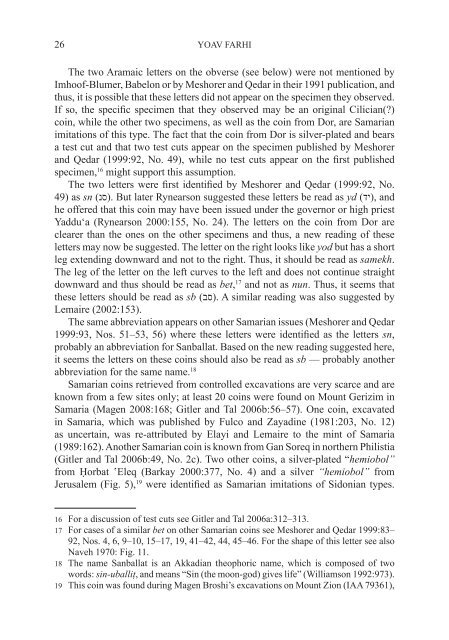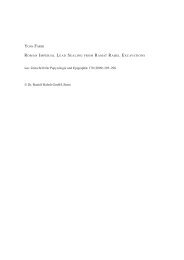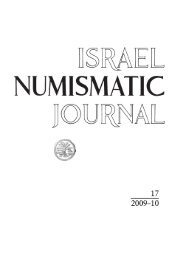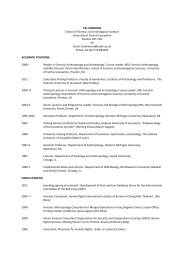Israel Numismatic Research - Institute of Archaeology
Israel Numismatic Research - Institute of Archaeology
Israel Numismatic Research - Institute of Archaeology
You also want an ePaper? Increase the reach of your titles
YUMPU automatically turns print PDFs into web optimized ePapers that Google loves.
26 YOAV FARHI<br />
The two Aramaic letters on the obverse (see below) were not mentioned by<br />
Imho<strong>of</strong>-Blumer, Babelon or by Meshorer and Qedar in their 1991 publication, and<br />
thus, it is possible that these letters did not appear on the specimen they observed.<br />
If so, the specific specimen that they observed may be an original Cilician(?)<br />
coin, while the other two specimens, as well as the coin from Dor, are Samarian<br />
imitations <strong>of</strong> this type. The fact that the coin from Dor is silver-plated and bears<br />
a test cut and that two test cuts appear on the specimen published by Meshorer<br />
and Qedar (1999:92, No. 49), while no test cuts appear on the first published<br />
specimen, 16 might support this assumption.<br />
The two letters were first identified by Meshorer and Qedar (1999:92, No.<br />
49) as sn (נס). But later Rynearson suggested these letters be read as yd (די), and<br />
he <strong>of</strong>fered that this coin may have been issued under the governor or high priest<br />
Yaddu‘a (Rynearson 2000:155, No. 24). The letters on the coin from Dor are<br />
clearer than the ones on the other specimens and thus, a new reading <strong>of</strong> these<br />
letters may now be suggested. The letter on the right looks like yod but has a short<br />
leg extending downward and not to the right. Thus, it should be read as samekh.<br />
The leg <strong>of</strong> the letter on the left curves to the left and does not continue straight<br />
downward and thus should be read as bet, 17 and not as nun. Thus, it seems that<br />
these letters should be read as sb (בס). A similar reading was also suggested by<br />
Lemaire (2002:153).<br />
The same abbreviation appears on other Samarian issues (Meshorer and Qedar<br />
1999:93, Nos. 51–53, 56) where these letters were identified as the letters sn,<br />
probably an abbreviation for Sanballat. Based on the new reading suggested here,<br />
it seems the letters on these coins should also be read as sb –– probably another<br />
abbreviation for the same name. 18<br />
Samarian coins retrieved from controlled excavations are very scarce and are<br />
known from a few sites only; at least 20 coins were found on Mount Gerizim in<br />
Samaria (Magen 2008:168; Gitler and Tal 2006b:56–57). One coin, excavated<br />
in Samaria, which was published by Fulco and Zayadine (1981:203, No. 12)<br />
as uncertain, was re-attributed by Elayi and Lemaire to the mint <strong>of</strong> Samaria<br />
(1989:162). Another Samarian coin is known from Gan Soreq in northern Philistia<br />
(Gitler and Tal 2006b:49, No. 2c). Two other coins, a silver-plated “hemiobol”<br />
from Ḥorbat ‛Eleq (Barkay 2000:377, No. 4) and a silver “hemiobol” from<br />
Jerusalem (Fig. 5), 19 were identified as Samarian imitations <strong>of</strong> Sidonian types.<br />
16 For a discussion <strong>of</strong> test cuts see Gitler and Tal 2006a:312–313.<br />
17 For cases <strong>of</strong> a similar bet on other Samarian coins see Meshorer and Qedar 1999:83–<br />
92, Nos. 4, 6, 9–10, 15–17, 19, 41–42, 44, 45–46. For the shape <strong>of</strong> this letter see also<br />
Naveh 1970: Fig. 11.<br />
18 The name Sanballat is an Akkadian theophoric name, which is composed <strong>of</strong> two<br />
words: sin-uballiṭ, and means “Sin (the moon-god) gives life” (Williamson 1992:973).<br />
19 This coin was found during Magen Broshi’s excavations on Mount Zion (IAA 79361),






